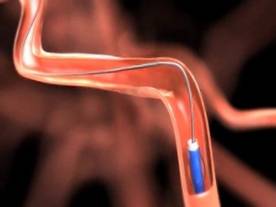When used as a first-line choice for the treatment of acute ischemic stroke secondary to large artery occlusion, the Solitaire FR revascularization device was safe and offered good recanalization rates and clinical outcomes, a multicenter study showed.
The Solitaire FR device, which mechanically removes blood clots from blocked vessels, received CE Mark approval in Europe and has been commercialized internationally by Covidien since November 2009. The Solitaire FR device was cleared in March of 2012 by the Food and Drug Administration.

Photo courtesy Covidien
The Solitaire FR revascularization device.
At the annual meeting of the Society of Neurointerventional Surgery, Dr. Vitor Mendes Pereira presented findings from 141 consecutive patients with acute ischemic stroke who were treated with the Solitaire FR device as first-line treatment to restore blood flow at clinical centers located in Geneva; Barcelona; Essen, Germany; Montpellier, France; Stockholm; and Bern, Switzerland, between March 2009 and July 2010. The researchers used an independent clinical lab to evaluate Thrombolysis in Cerebral Infarction (TICI) scores on pre- and postprocedural angiograms.
Dr. Pereira, one of the investigators who heads the section of interventional neuroradiology at University Hospital of Geneva, said that complete recanalization was defined as TICI 2b or 3 post treatment. He and his associates defined good early neurologic outcome as a National Institutes of Health Stroke Scale (NIHSS) score improvement of 10 or more points or a NIHSS score of 0 or 1 at hospital discharge. They defined favorable outcome as a modified Rankin Scale score of 2 or less at day 90.
The mean age of the 141 patients was 66 years; 44% were women. Their median NIHSS score was 18, and 52% of patients were treated after previous treatment using intravenous tissue plasminogen activator (TPA). Most of the occlusions were located in the anterior circulation (86%), and 46% corresponded to M1 occlusions.
Dr. Pereira reported successful revascularization in 85% of patients with a TICI of 2b or greater, 96% for those with a Thrombolysis in Myocardial Infarction (TIMI) score of 2 or greater, and 83% for those with an Arterial Occlusive Lesion (AOL) score of 3.

Dr. Vitor Mendes Pereira
Nearly three-quarters of cases (74%) were performed using a balloon-guided catheter. Technical success was achieved in 97.8% of patients, and the median time to groin puncture was 40 minutes. The mean number of passes was 1.8, and 77% of patients achieved recanalization success with up to two passes. Rescue therapy was required in seven cases (4.9%).
Nearly one-third of patients (32%) achieved a good neurologic outcome at hospital discharge and 55% had a modified Rankin Scale score of 2 or less at 90 days. The rate of death at 90 days was 26%, and 6% experienced intracranial hemorrhage.
The study was funded by Covidien. Dr. Pereira disclosed that he is a consultant for Covidien and is the principal investigator for two studies funded by the company.


0 Comments